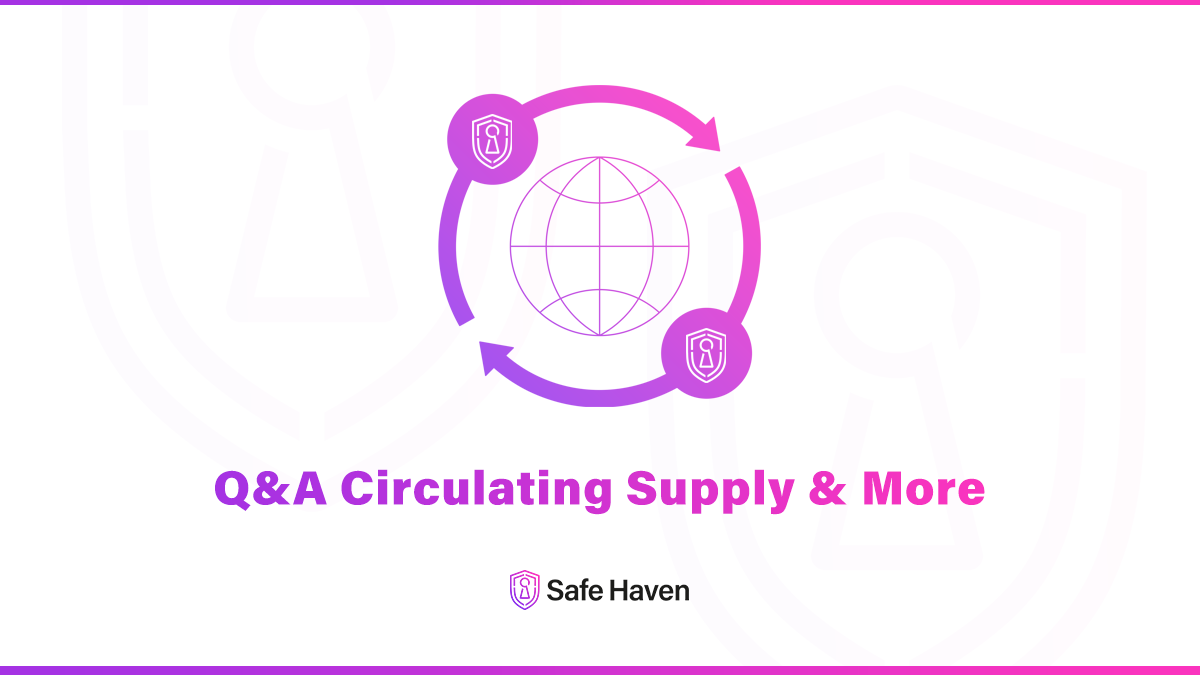

As indicated in the weekly report to our community, Flash Friday December 22, 2023, we provide you with more comprehensive information regarding circulating supply, available financial resources, and other financial aspects of the Safe Haven organization. This Q&A article elaborates on the questions shared in the community channels. With the article we aim to provide you with insights into our operations and decision-making processes.
How come circulating supply went from 66% to 100%?
The interpretation of the definition of circulating supply in crypto has undergone changes over the years. While some platforms still follow varying definitions, our internal discussions have led us to adopt the following: circulating supply encompasses all tokens that are not locked and are readily available on the market. As a result, our circulating supply stands at 100% as there are currently no tokens locked in smart contracts anymore, the safenodes and staking pools are soft-locked and we will not mint additional tokens.
At the beginning, a significant number of ICO contributors’ SHA tokens were locked. In addition, the tokens kept in Safe Haven’s treasury for development purposes and business operations were also considered locked. After an internal discussion, we made efforts to adjust the presentation of circulating supplies on Coinmarketcap and Coingecko. The adjustment has been a long term process, but we are confident that the current approach is the right way of presenting, and accurately reflects the current situation. The decision to adopt a clear and consistent definition of circulating supply and adapt the circulating supply to 100%, is driven by providing transparency and clarity to our holders and the wider cryptocurrency community. We hope to eliminate confusion and facilitate accurate valuations and comparisons.
How did the foundation issue their SHA tokens from ICO?
During the initial coin offering (ICO) and private sale, 42% of the SHA tokens were sold in exchange for VET and ETH. Those funds were utilized for covering development costs in the early years. A significant portion of the remaining SHA tokens was allocated towards exchange listings and providing liquidity, this amount greatly exceeded the initial estimate. The remaining SHA tokens were strategically exchanged during the last bullish market cycle and used to cover development, patent, and other organizational expenses. This exchange process was done by providing liquidity to the market makers to prevent token dumping. This approach is taken to safeguard the company’s and SHA holders’ best interests. To gain further insights into the movements of tokens on centralized exchanges, exploring the operational mechanisms and underlying business models of exchanges would be a fascinating avenue to explore.
Where is Safe Haven getting money from and is there enough funding for further development?
Safe Haven’s current treasury consists of stable coins, large-cap cryptocurrencies, and around 300M SHA tokens. Our funds come from utility sources such as swap fees (gas tokens), SafeSwap listings (stable coins), and Inheriti® plans (SHA tokens). We also receive grants paid in the native tokens of the grant supplier. Additionally, we generate revenue through SafeTech and the work we do for other companies. Our current funding sources provide sufficient funding for further development of Inheriti 2.0, Vault, Mobile and Safekey 2.0, including accelerating development and the initiation of marketing efforts. It also provides a buffer for unforeseen challenges, fluctuations in market conditions and the ability to invest in growth opportunities. Additionally, it is worth noting that the founders still retain 100% ownership of the company and there is the potential to secure additional funding through venture capitalists or grants.
Where do the node rewards come from?
Node rewards come from utility sources such as Inheriti® and SafeSwap. Later on a percentage of the SafeSwap listing fees were added for the time being. The node rewards are distributed once a year to SafeNode holders.
Where is the SHA for staking coming from?
The SHA tokens for staking are allocated through a buyback program that took place in 2020. The Staking Program is intended to be temporary, only until node rewards reach a point where staking is no longer necessary for compensation. Each year, a decision is made on whether to prolong the Staking Program. In November, it was determined that the program will be extended in 2024.
Are SHA tokens still being burned?
In 2023, we focused on being as compliant as needed to build a sustainable long-term company. As part of this strategy, we are working towards attaining the ISO 27001 certification starting in 2024. Burning tokens is a debated topic, and due to the legal and tax implications associated with it, we had to decide not to burn SHA tokens at the moment. We understand this could be a disappointment and we apologize that this was unforeseen in earlier years. We will allocate the burning amount for marketing purposes, exchange liquidity and partnerships, to have it contribute to the development of a robust and enduring company, which ultimately benefits all SHA and node holders.
Back to news


